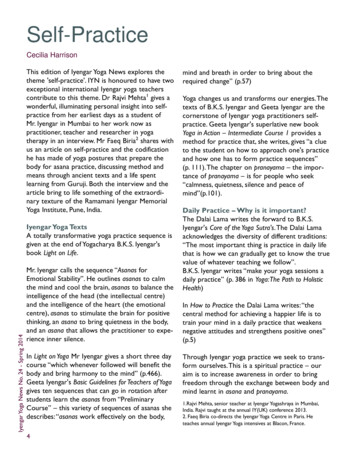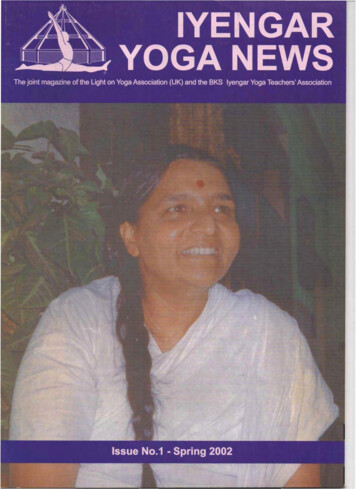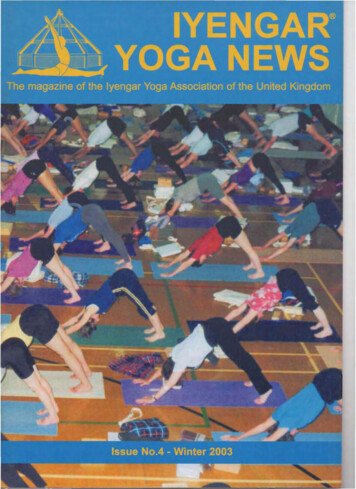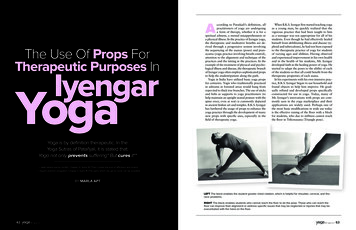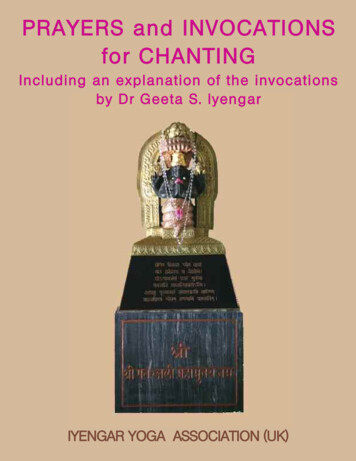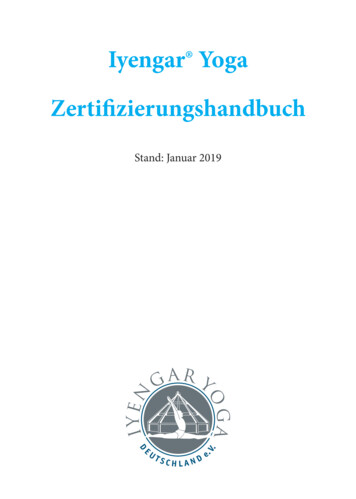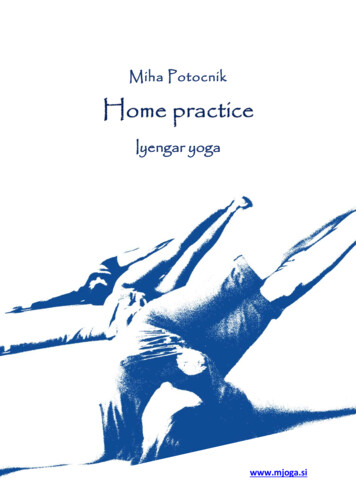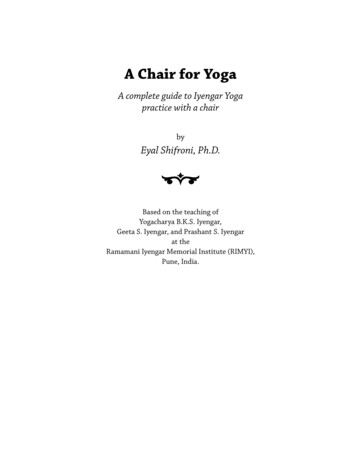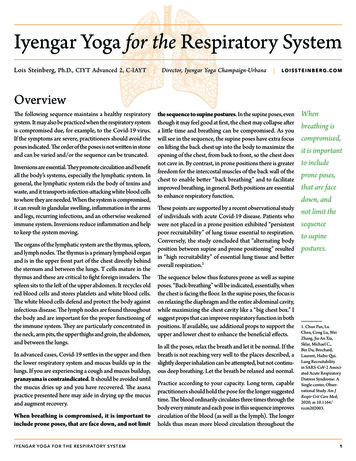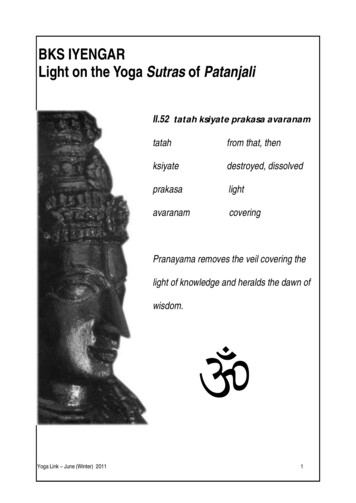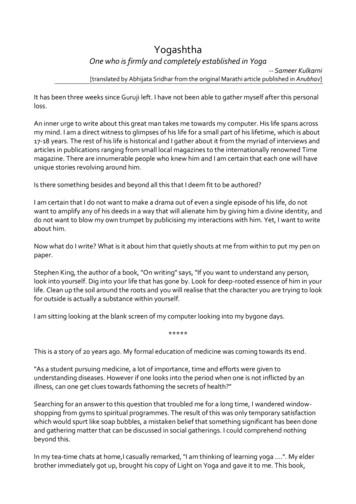
Transcription
YogashthaOne who is firmly and completely established in Yoga-- Sameer Kulkarni[translated by Abhijata Sridhar from the original Marathi article published in Anubhav]It has been three weeks since Guruji left. I have not been able to gather myself after this personalloss.An inner urge to write about this great man takes me towards my computer. His life spans acrossmy mind. I am a direct witness to glimpses of his life for a small part of his lifetime, which is about17-18 years. The rest of his life is historical and I gather about it from the myriad of interviews andarticles in publications ranging from small local magazines to the internationally renowned Timemagazine. There are innumerable people who knew him and I am certain that each one will haveunique stories revolving around him.Is there something besides and beyond all this that I deem fit to be authored?I am certain that I do not want to make a drama out of even a single episode of his life, do notwant to amplify any of his deeds in a way that will alienate him by giving him a divine identity, anddo not want to blow my own trumpet by publicising my interactions with him. Yet, I want to writeabout him.Now what do I write? What is it about him that quietly shouts at me from within to put my pen onpaper.Stephen King, the author of a book, "On writing" says, "If you want to understand any person,look into yourself. Dig into your life that has gone by. Look for deep-rooted essence of him in yourlife. Clean up the soil around the roots and you will realise that the character you are trying to lookfor outside is actually a substance within yourself.I am sitting looking at the blank screen of my computer looking into my bygone days.*****This is a story of 20 years ago. My formal education of medicine was coming towards its end."As a student pursuing medicine, a lot of importance, time and efforts were given tounderstanding diseases. However if one looks into the period when one is not inflicted by anillness, can one get clues towards fathoming the secrets of health?"Searching for an answer to this question that troubled me for a long time, I wandered windowshopping from gyms to spiritual programmes. The result of this was only temporary satisfactionwhich would spurt like soap bubbles, a mistaken belief that something significant has been doneand gathering matter that can be discussed in social gatherings. I could comprehend nothingbeyond this.In my tea-time chats at home,I casually remarked, "I am thinking of learning yoga .". My elderbrother immediately got up, brought his copy of Light on Yoga and gave it to me. This book,
authored by B.K.S Iyengar had beautiful photographs, an attractive layout and papers that werebeautiful to touch. The book was top-notch. In the first page, my brother wrote, "This is a bookfor study, not just for reading. If proper study of this book is undertaken, reading any other bookbecomes redundant.""Aye! If so, why did you not give this to me before", I asked him."Everything needs commensuration with time. Anyway, you start your study. If you follow theinstructions given in this book to a tee, it is impossible for you to go wrong." Without any scope topursue the conversation, he walked away.I started my study. In due course of time, I felt I got a hang of all the primary instructionspertaining to the body. I also began to have fun while performing the simple asanas."All right about the book. But why don't you go to Guruji himself? Why don't you go to theinstitute? People from all over the world come reverentially to learn from him and you can't go afew kilometres?", he asked with deep concern tinged with exasperation.He was right. Such confrontations happened 4-5 times and yet I remained lackadaisical. "I shouldgo, but I don't have time, it is not possible". Many reasons would be contrived. My estimategathered strength as I even gained solace from friends for all those reasons. What was the reality?What was I apprehensive about? What made me weak in my knees to not go there? Only I knewdeep inside what the real reason was.In my college days, there were two luminaries whose lives occupied my mind. I borrowed theopinions of authors of articles and posed those as my own. No need to point fingers at the author,the fault was mine.The first luminary was Vinoba Bhave.He was a simpleton who wouldn't understand the questions of the contemporary minds. That hecould go into shoonyavastha was reason enough to ridicule him. It was fashionable for the cafeintellectuals to remark absolutely anything about him. I fell a victim to that 'fashion'. By readingnot even a single letter of his literary works, I heedlessly passed so called expert retrogressiveimaginative comments. Ten years had to pass by before it dawned upon me that I was beingfoolish and stupid.The second luminary was BKS Iyengar. If you went to him to learn asanas, he would beat you, siton you and break your back. This was the notion that I borrowed from articles in newspapers andmagazines. (On his 95th birthday, Guruji said on the dais that in the olden days BKS waspopularised as an acronym for 'Beat, Kick and Shout Iyengar). The stark reality was that I wasapprehensive about just his impression which I settled to - that of an intense, short-tempered andstern yogi from whom who you could get a kick even if you just looked at him.However my brother was persistent. Somehow, I finally took admission to the classes in theinstitute.When I first went to the Ramamani Iyengar Memorial Yoga Institute 17-18 years ago, Guruji wasclose to 80. By then, Guruji had stopped teaching in the general classes. However one couldalways see him in the therapy classes. At other times, his tryst with his chosen subject was on. Hispractice time was fixed and he could be seen in the hall practising in those time slots. He assumedhis position of asanas often with the use of sticky mats, bricks and bolsters. I instinctively deferred
from going close to him while he was in practice. Just seeing him was such a magnificent treat.Even if he was silent, even if he did not teach anything, one could somehow sense that he wasaround a great man. An inexplicable driving force was there by his mere presence."Body is my temple and asanas are my prayers." Along with the memory surrounding thisstatement, Guruji's dedicated practice exemplifying this statement comes to my vision eventoday.However back then, I would see him only from a distance. This was so for many years.*******Actually, I am a student of Prashant Iyengar. While learning from him, the fear of the subject ofyoga was put to rest. There is a relationship between the body and yoga, but that is not the endof it. It is a complete Darshana that transcends the body - this realisation came to me because ofhim. The questions for which I was looking desperately for answers were cleared because of histeachings.One day in class, he made us do Eka Pada Rajkapotasana. We pulled the leg to the head withawkward faces, holding the breath and biting the teeth and lips. Prashant sir saw our battle forsometime and said unexpectedly sharply, "Release the asana.""Come here", he led us towards a photo in the hall.In the main hall in the institute, there is a display of many blown-up photographs from Light onYoga. Prashant sir stood near the photo of Eka Pada Rajkapotasana. We followed him. Hepointed towards that photograph. How Guruji did what we were trying to do was palpable.Beauty and a master-piece that cannot miss one'e eye. Whatever Svatmaram has mentioned inHathayoga Pradipika - angalaghava i.e lightness of the body etc.all that was crystal clear.Nothing needed to be said."Don't look at the pose", Prashant sir posed an impenetrable wall. Naturally I was also bewildered."Take note of his face. There is not a single freckle on his forehead, eyes are passive and pure.Examine his entire body and its senses, every nook and corner of it. It is all a clear reflection ofhow relaxed he is. Understand this peaceful condition. Understand the quietude. His sensitivity isalert, aware and total even in this difficult position. Can you realise this? We do the asana, andGuruji actualises yoga - this is the essential difference between Guruji and ourselves. "In a moment I felt as though someone lit me up with an intensely sharp and bright torch. Thedarkness was gone.********On the next day, I went to the institute hall at a time when none would be there. Believe it or not,I checked each and every photograph in the hall. What Prashant sir said was absolutely glaringlytrue. The peaceful composure was not disturbed in even a single asana. Not even a single part ofthe body or not even the skin showed any looseness or stress. (These photographs were taken in1962 - in the days before Photoshop happened. There was no possibility of any editing or touchup. Even if the face of any asana was pasted on to the body of any other asana, it would not seem
out of place - such a profound singular serenity. An equanimity of the highest character thatTadasana turned topsy-turvy became Sirsasana and Sirsasana turned, indeed became Tadasana!"We do the asana, and Guruji actualises yoga". I have rarely heard a statement that gives such aclear understanding.I still remember how mesmerised I was by Guruji's performance of Padangushtha Dhanurasana inhis later years. I felt strange that a man who could do such a mesmerising PadangushthaDhanurasana lived close-by. It felt queer that he still lived in that house.Just then I heard Guruji laughing heartily. Just outside the house, he was saying something tosomeone and was laughing rapturously and earnestly. He wore on his lower body a garment thatis called a 'veshti', a silk Kurta covered his trunk, white silken hair was cleanly combed backwards,fierce eyebrows blazed forth and there was a long bright red mark on his forehead called'Sricharan'. It was not just his face, but his entire being participated in that laugh.I came down and prostrated."Namaskar.Namaskar", he said hastily, I thought.It was only after some more years passed by I realised that whenever I touched his feet, he wouldvery lovingly say 'Namaskar' twice consecutively."You are practising regularly, aren't you?", he asked while taking his hands off me after blessingme. While we were not acquainted, that was his first question to me. I just nodded my head in away that would not express a 'no' and stepped aside. He then turned towards the conversationwhich he was having and again laughed aloud.Guruji faced life whole-heartedly. Guruji who faced living full of life had cast a spell upon me. I wasenchanted. "Guruji knows what yoga is. He knows Patanjali's teachings from within. Even if youfollow him blindly, you will reach from wherever you are to such higher planes", my brother toldme while giving me his copy of 'Light on yoga sutras'I soon started studying Guruji's other books earnestly. I also saw DVDs of his teachings of manyyears. I keenly listened to every word that he said. In order to understand that, I tried toimplement his teachings in my own practice. When he was practising in the institute I would justspend hours seeing him and taking cognisance of whatever he did.A realisation dawned upon me. If I had to learn something from Guruji it was his relationship withlife and living. This is yoga.*******The first instance when I saw Guruji teach live was during his 85th birthday. In that course, on acouple of days I sat in the steps during the lesson. Here is what comes in waves of my memory ofthose lessons:"We have created the system of 4 castes in our own body - Brahman, warrior, tradesman andslave. We give the status of Brahman to the head because our intellect functions from there. Thework of undertaking the functioning or trade of the body is bestowed upon the neck, chest andstomach - to take in something, extract nourishment from it and to discard what is not needed. If
you look at your hands, you will recognise that they belong to the class of warriors. Their purposeis for protection. If there is an attack, the onus is on the hands to respond. The legs are the slavesof the body. The have to bear the whole body throughout one's life, without any objection.However have you ever given a thought that you should break this caste system prevalent in yourown body?"I was not quite sure what he wanted to convey. For a moment I was in jitters whether he wastrying to endorse the caste system."Why don't you make the head do the job of the legs at some point in time or guide the hands togo hand in hand with the stomach? Do you have those internal connections? When we go toSirsasana.", he turned towards the student on the platform and said, "Go to Sirsasana". Such agrounded instruction, I had never heard. The force and clarity with which he said that was sosignificantly special that it was as if Sirsasana would come alive with that coarse voice itself."What do you mean when you say, 'I do Sirsasana'? Just stand on your head? Manage balance? Onone plane, of course we do so. However the bigger lesson is we make the head to experiencewhat it is to do the job of the legs. Understand what a distinctive feat it is to bear and balance theentire weight of the body and how the legs do so without any hesitation. You have doneSirsasana for so many years. What have you learnt? When you bestow the responsibility of thehead upon the legs, what do you convey to them?You tell them to look into the space all around. Let eyes of sensitivity sprout forth from your skin.With their assistance, can you gauge your position in this time and space? At other times, howinstantaneously your brain does this.do you realise that? When roles are interchanged, weunderstand the value of each role. Just see. We change the context and the entire understandingchanges. This is what Patanjali tells you when he says, 'vitarka badhane pratipaksha bhavanam'.There were a couple of people from overseas who were sitting next to me in the stairs
When I first went to the Ramamani Iyengar Memorial Yoga Institute 17-18 years ago, Guruji was close to 80. By then, Guruji had stopped teaching in the general classes. However one could always see him in the therapy classes. At other times, his tryst with his chosen subject was on. His practice time was fixed and he could be seen in the hall practising in those time slots. He assumed his .

